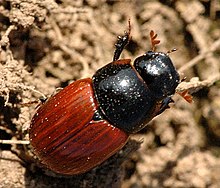Cow dung
As cow dung are excrement of cattle called. The individual intestinal excretion of a cow is the cow patty , also called the cow patty in Austria .
description
A typical cow patty is about 30 cm in diameter and weighs up to two kilograms when wet. An animal produces eight to ten flat cakes a day. In wet weather, the flatbread decomposes in two to three months, is a habitat for numerous insects and is used by them both as a nutrient ( coprophagia ) and for laying eggs in order to use the heat generated by the decomposition. Over-fertilization occurs around a cow dung. The grass grows particularly lush, but is not eaten by the animals, it creates a pile of horns . In dry weather, cow dung can also dry out and can then be used as fuel.
use
Because of its organic components, cow dung is used as a fertilizer in Central European agriculture ; In addition, the methane produced during fermentation of this excrement in the absence of oxygen can be used to generate biogas . A cow dung contains so much thermally usable chemical energy that 0.1 kilowatt hours of electricity can be generated from it.
In some tree-poor high mountain regions and plateaus in the Alps , Tibet , India and Turkey , cow dung was or is of considerable economic importance because it is used as heating material when dried . But since they can be used much more profitably as fertilizer, attempts are being made to create a substitute by developing more effective solar cookers . On the wood-poor Halligen , this fuel was called ditten .
Cow dung is also considered to be an excellent building material , either as an additive to building clay or in its pure form in large areas of Africa as plaster for wattle huts. In India, fresh cow dung was traditionally used as a floor covering, especially in kitchens - it was said to have a cleaning effect. For this purpose, a thin layer of dung was applied to the clay floor of the room every day, which after a short time hardened to a hard and odorless surface.
Cow dung is also used in mixtures for painting trees .
Natural decomposition
Immediately after laying, various flies and beetles such as the common dung ball beetle and the common dung beetle appear to lay eggs. Their larvae develop rapidly in the semi-liquid substrate. In a second phase, other flies appear on the still moist cow dung, which is already pervaded by feeding and excrement passages, including the golden-yellow haired dung fly Scathophaga stercoraria . Only their larvae eat dung, the flies themselves are sometimes predatory. Various short-winged birds and their larvae also hunt other people living in the faeces.
The flat cakes, which are now hard on the outside, but still moist on the inside and with corridors, develop types of fungi such as the grainy beef dung cup , yeast and bacteria , which further break it down. It crumbles, grass grows through it, mites , centipedes and earthworms live in the subsoil. The remains are chopped up by birds in search of food or buried by dung beetles .
Since industrial factory farming is increasingly replacing pasture farming in Germany, there are fewer and fewer cow dung. The natural habitat of dung beetles, common dung beetles and other insects is therefore disappearing. Furthermore, the antiparasitics such as avermectins are a danger to the insects living in or from the cow dung.
See also
literature
- Werner Nachtigall: Habitats. Central European landscapes and ecosystems. BLV Verlagsgesellschaft, Munich, 1986 ISBN 3-405-13254-1
Web links
Individual evidence
- ↑ ReefReporter: The Dying of Dung Beetles . Retrieved August 14, 2020 .




